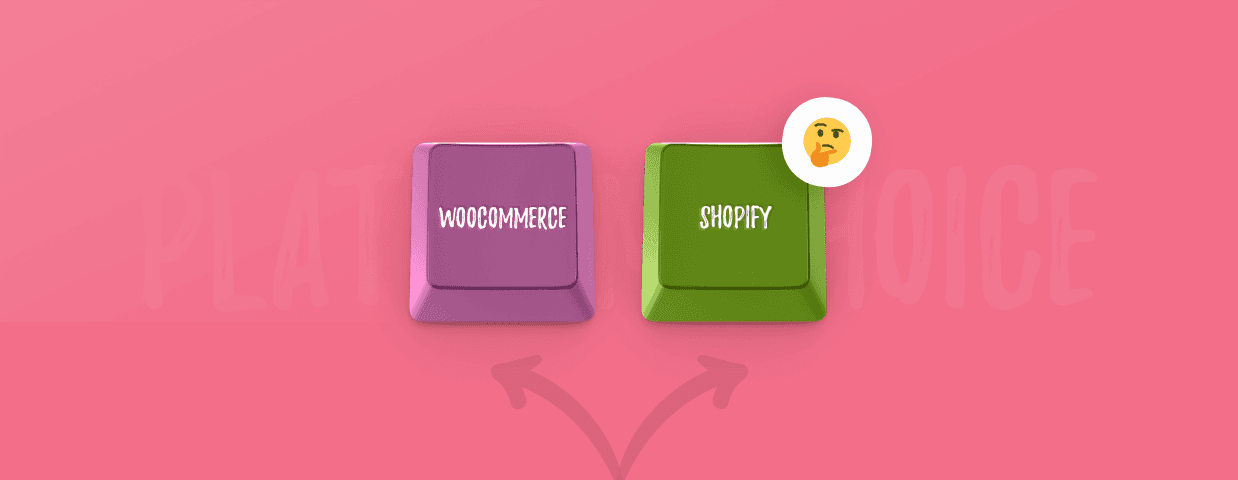It’s a tale as old as online shopping—what is the best ecommerce platform for my store?
Usually, it boils down to one battle: WooCommerce vs Shopify.
Researching online reviews doesn’t help—both have die-hard user bases. Reading about pros and cons doesn’t help either—both have a wide range of excellent features.
“Why can’t somebody just tell me what to do?” you think.
Don’t worry. We’ll help you decide which of the two giants you should choose for your business.
In this article, we’re comparing the most important aspects of WooCommerce and Shopify side by side:
- Pricing
- Setup time
- Integrations and plugins
- Design and themes
- Ease of use
- Security
- Transaction fees and payment options
- Sales features
- Marketing features
- SEO capabilities
- Customer support
- Dropshipping suitability
Plus:
Learn how Tidio helped ADT Security boost its customer experience
Not what you were looking for? Check out these articles instead:
- How to Use WordPress to Make a Website
- Top 8 ecommerce Platforms
- Ecommerce Website: How to Build Yours
What’s the difference between WooCommerce and Shopify?
Before we jump into the analysis of each of the aspects that are crucial for decision-making, have a look at our TL;DR version, summing up the results of our ranking:
WooCommerce vs Shopify: comparison table
| WooCommerce (5/12) | Shopify (8/12) 🏆 | |
|---|---|---|
| Pricing | 🏆 Open-sourced with relatively low costs of maintenance and extras | Fixed-priced plans, relatively expensive |
| Integrations and plugins | 🏆 Offering over 50k integrations and plugins | Offering around 4k integrations and plugins |
| Setup time | Requires basic technical skills and takes longer time | 🏆 Easy to start with an automated setup |
| Design and themes | A single, pre-designed theme you can customize. Possibility to buy additional themes | 🏆 A variety of pre-designed themes with a sleek look, easy to customize |
| Ease of use | More technical, for tech-savvy users | 🏆 Easy to use, even for beginners |
| Security | All security features must be sourced, usually by a web-hosting provider | 🏆 Built-in SSL certificate, PCI-DSS compliant by default |
| Transaction fees and payment options | 🏆 No transaction fees | Charges up to 2% per transaction unless you use their dedicated payment solution |
| Sales features | Paid sales features | 🏆 Built-in sales features |
| Marketing features | Paid plugins for multichannel selling and email marketing | 🏆 Free multichannel selling and email marketing |
| SEO capabilities | 🏆 WordPress-based with a wide range of excellent SEO plugins | A limited number of SEO plugins |
| Customer Support | Extensive knowledge base and the possibility to fill the ticket, no official 24/7 support | 🏆 24/7 customer support, and knowledge base |
| Dropshipping | 🏆 Easy to set up, many integrations available, no product restrictions | 🏆 Easy to set up, many integrations available, mandatory product policy |
Undeniably, Shopify and WooCommerce are ecommerce behemoths.
Shopify claims it powers over 1.9M online stores. WooCommerce, on the other hand, is powered by WordPress, the most popular content management system in the world (hosting 28M+ websites).
The main difference between the two is that Shopify is a full-fledged ecommerce platform, while WooCommerce is an open-source plugin that transforms any WordPress website into a commercial website.
This influences a number of aspects.
Shopify is reliable, easy to use, and offers excellent customer support. It may not be as scalable and flexible as its competitor, though.
In contrast, WooCommerce offers limitless customization, great value for money, and has fantastic flexibility. Conversely, it might not be the best solution for those who lack technical skills and a DIY spirit.
As you can see from the table above, we favored Shopify over WooCommerce. However, it doesn’t mean you should blindly choose it as your ecommerce platform just because it won our ranking. Every business is different, so first, you want to deep-dive into the analysis of each aspect and see which features are crucial for you. Let’s do it!
WooCommerce vs Shopify: pricing
This is one of the most important aspects for many ecommerce store owners: the price of using the platform and what it includes.
The winner in this category is: WooCommerce.
Why?
It costs between $14-$30 per month to cover the basic features of WooCommerce, and between $200-$1000+ a year if you want to move beyond the basics. Shopify, on the other hand, will cost you anywhere between $29-$299+ a month.
| WooCommerce Pricing 🏆 | Shopify Pricing |
|---|---|
| – Platform access: open-source +Additional costs: – Dedicated hosting plan powered by Bluehost: Starter: $13.99/month Plus: $17.99/month Pro: $31.99/month – Security: $0 – $200/year – Domain: $10 – $20/year – Extension fees: $0 – $100/month | – Shopify Basic: $29/month – Shopify: $79/month – Advanced Shopify: $299/month |
| Free trial: not needed due to free access | Free trial: 14 days free trial |
The main difference
The main difference between WooCommerce and Shopify when it comes to pricing is that Shopify offers fixed monthly pricing with a specific range of features. WooCommerce, on the other hand, is free of charge, but you need to add extra costs such as domain name, web hosting provider, security, and other extension fees. WooCommerce sites are usually hosted by Bluehost, a web hosting company providing dedicated WooCommerce packages.
Where does WooCommerce beat Shopify?
Sure, Shopify offers advanced features (such as professional reports), as you upgrade the plan. Yes, it’s clear pricing plans make it easier to track the costs. But overall, it’s at a hefty price point compared to its competitor.
WooCommerce is much cheaper and easier to get started with. Even if you pay for hosting, security, and extra add-ons (on average, $39 per extension), you can still spend less than using Shopify on a month-to-month basis.
Worth mentioning
On top of the usual plans, Shopify provides custom solutions:
- Shopify Lite enables you to add “Buy now” buttons to your website (for $9/month)
- Shopify Plus, an enterprise solution available via quote only.
WooCommerce doesn’t provide any “special” plans because the customization lies at the very core of the platform’s existence. Enterprise-sized companies will enjoy the fact that it is created with web development in mind, allowing to add as many extensions as it’s needed.
In one of the threads about WooCommerce vs Shopify, a Reddit user said this:
Shopify is like signing up with an aggregator over a merchant account provider. (…) It’s going to cost an arm and a leg over time as you grow. WooCommerce is cheaper, hands down.
Suggested read
Read more about Shopify pricing plans.
Shopify vs WooCommerce: integration and plugins
The possibility of adding extra functionality to an online store is crucial to the majority of ecommerce businesses. It enables them to focus on SEO and marketing optimization, as well as improve customer experience by adding various payment methods and shipping options.
The winner in this category is: WooCommerce.
Why?
WooCommerce is open-source software, and using plugins for the majority of the functionalities lies at its core. That’s why it seamlessly integrates with around 50k plugins, as opposed to the competitor that has “only” 4k paid and free plugins to choose from in the Shopify app store.
| WooCommerce 🏆 | Shopify |
|---|---|
| – 50k plugins – Almost all plugins integrate seamlessly with the platform | – 4k plugins – Not all plugins are worth recommending, and they require a bit of research and review-scanning |
The main difference
In general, plugins can be described as “less essential” extensions. However, WooCommerce’s main characteristic is customization, so it’s understandable why this free ecommerce solution relies heavily on WooCommerce plugins, and easily integrates with the majority of plugins on the market.
Where does WooCommerce beat Shopify?
WooCommerce lets you build a vast ecommerce site with limitless features provided by numerous plugins and integrations. Shopify also offers a lot of plugins to choose from. However, the number is significantly smaller, not leaving much room for experimentation and iteration. On top of that, WebsiteBuilderExpert reports that only around 1.2k out of 4k are reliable.
One Quora user said this about WooCommerce:
With WooCommerce, you have access to hundreds of brilliant plugins and extensions which allow you, as a store owner, to grow and adapt your store as you start to make money.
Suggested read
See the best Shopify apps for your store.
Worth mentioning
Both WooCommerce and Shopify integrate with Tidio, a customer service platform offering live chat for instant customer support, and chatbots for abandoned cart recovery.
Learn how Tidio helped ADT Security boost its customer experience
Shopify or WooCommerce: setup time
Nasdaq reports that by 2040, around 95% of all purchases are expected to be made via ecommerce. This may indicate that a lot of shop owners wish to be up and running in the online world ASAP. That’s why the relatively fast starting time is another essential criterion when it comes to choosing the right platform for your online shop.
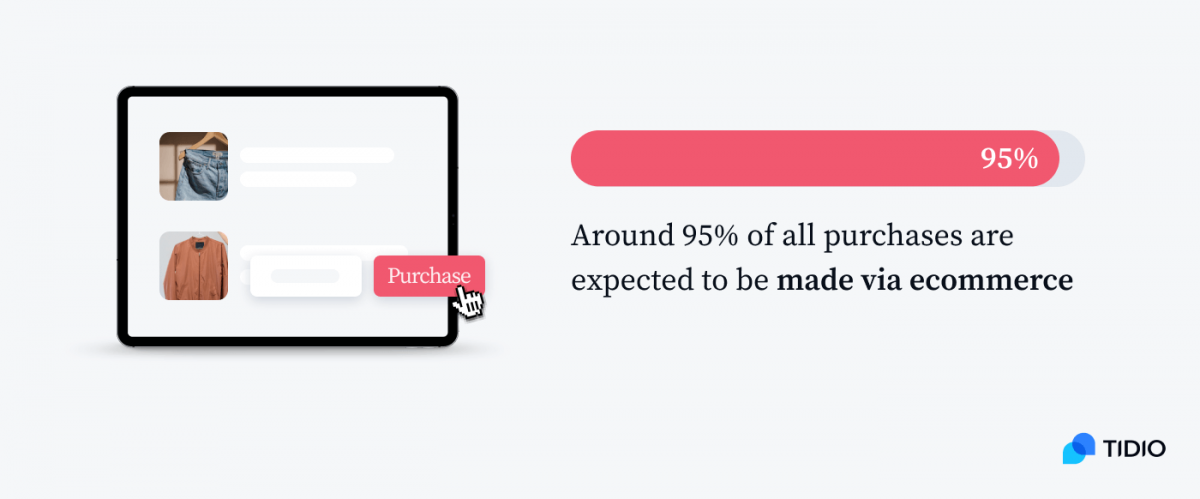
The winner in this category is: Shopify.
Why?
If you are building an online store from scratch, Shopify is easier to use. Its key website builder features are included in every Shopify plan, so the setup time is much quicker than WooCommerce’s.
| WooCommerce | Shopify 🏆 |
|---|---|
| – Manual setup – Your own design – More flexibility | – Automated setup wizard – Pre-designed themes – Quicker launch |
The main difference
Building a WooCommerce store gives you more creative control over what the shop looks like. On the other hand, the process is manual, requiring skills and dedication. This makes it more suitable for users who don’t care so much for putting themselves “out there” right away. Shopify, on the contrary, offers a setup wizard that guides you through the process step-by-step.
Where does Shopify beat WooCommerce?
Shopify combines all basic ecommerce functionalities with a quick, automated setup. It enables you to quickly build your ecommerce by using design themes and make your online presence known in no time.
Worth mentioning
WooCommerce’s basic website setup is relatively easy. But if you treat building your ecommerce as a creative project, there are many extensions and plugins that help you adapt as you grow. It all depends on your approach and whether you are able to trade the flexibility of WooCommerce for a more “practical” take provided by Shopify.
One Reddit user said this when comparing the setup of the two:
When people say WooCommerce is cheaper, they don't factor in the cost of their time configuring it and customizing it. And there are crucial tasks like speeding the site up, backing up, picking the web host with high uptime. Shopify, you can start in a weekend.
WooCommerce or Shopify: design and themes
As many as 42% of US consumers said they were “very unlikely” to make a purchase from a website they viewed as ugly. Moreover, 21% said they were “not likely at all” to buy anything from an unattractive or unprofessional website, based on the survey conducted by Vistaprint. Conclusion? Aesthetics matter in the ecommerce world! Which of the two platforms have higher chances to conquer your visitor’s eye?
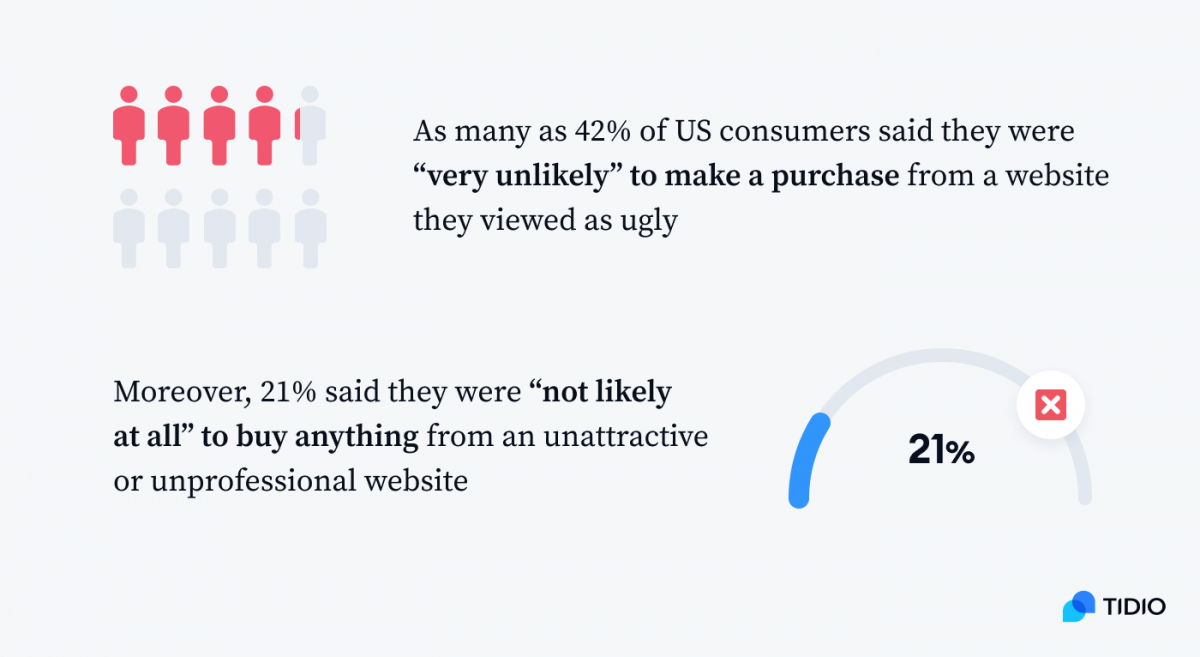
The winner in this category is: Shopify.
Why?
Shopify offers 70 sleek design themes that can be easily customized. WooCommerce enters the competition with one, far less polished entry theme that is possible to customize to your liking.
| WooCommerce | Shopify 🏆 |
|---|---|
| – One built-in entry theme – Possibility to buy a variety of WooCommerce themes created by external designers – The level of customization is endless, but it is based on your technical skills | – A variety of 70 built-in paid and free themes of high quality – Possibility to use variations of specific themes – Premium themes, starting from $140 in the dedicated theme store – Easily customizable |
The main difference
Even basic Shopify’s themes are very polished, offering a sleek look for any type of store (health & beauty, jewelry & accessories, electronics, sports, toys, etc.). WooCommerce offers a singular entry theme, Storefront. And while its customization possibilities are limitless, you need to have skills and time to make it look exactly as you want.
Where does Shopify beat WooCommerce?
Apart from offering 70 theme templates, Shopify makes it possible to use their exceptional variations, which sums up to around 100 separate designs. They are easier to customize, and they look more refined. WooCommerce doesn’t deliver specific designs on its own.
Worth mentioning
If you want to keep using WooCommerce and don’t want to spend time customizing their entry theme, there is another solution. As an alternative, you can purchase one of the WordPress themes dedicated to ecommerce, like the ones available on ThemeForest.
One Quora user said this:
When it’s designing that we’re talking about, Shopify definitely has the upper hand. Its greatest selling point is the quality of their visual themes.
Suggested read
Read about what makes a website trustworthy.
Comparing WooCommerce to Shopify: ease of use
Whether the platform is easy to use is crucial, especially for beginners in the ecommerce field. Not every store owner wants to learn how to code or do backups, so let’s see which of the options is easier to use.
The winner in this category is: Shopify
Why?
WooCommerce requires basic technical skills for comfortable management, while Shopify represents the “everyman’s platform” with ease of access and use.
| WooCommerce | Shopify 🏆 |
|---|---|
| – Web hosting is the owner’s responsibility – The relatively steep learning curve – Good for tech-savvy users | – A hosted platform, maintained by the provider – Accessible to the everyday person – Good for beginners and regular users |
The main difference
WooCommerce plugin is a relatively technical-based solution. You need to have basic knowledge about software, website security backups, and domain hosting in order to use it comfortably. Shopify, on the other hand, offers a full package when it comes to maintaining the technical side of the online store.
Where does Shopify beat WooCommerce?
With Shopify, you don’t have to install or update any software, as it’s fully maintained by the platform itself. This makes it worry-free and more accessible for a “regular user”.
Worth mentioning
Bluehost, a dedicated WooCommerce web host provider, includes a free domain and website protection in its WooCommerce hosting plans. This makes WooCommerce a bit more accessible to a user, even if the convenience is provided by a third party.
One Reddit user said this when comparing the two:
You definitely need to know more to use WooCommerce. (…) You will spend more time managing/setting things up when you could be investing that time in growing your actual business.
Suggested read
Read more about how Shopify works or read the Magento vs Shopify comparison.
Shopify and WooCommerce: security
Security should be a priority for any ecommerce website. In fact, around 46% of users said they wouldn’t enter their information on the site without an SSL certificate. Furthermore, as many as 64% of consumers said they’d leave the website instantly. After all, you are not only processing customers’ payments, but you are also storing their personal information. Which platform offers better security? Let’s see.
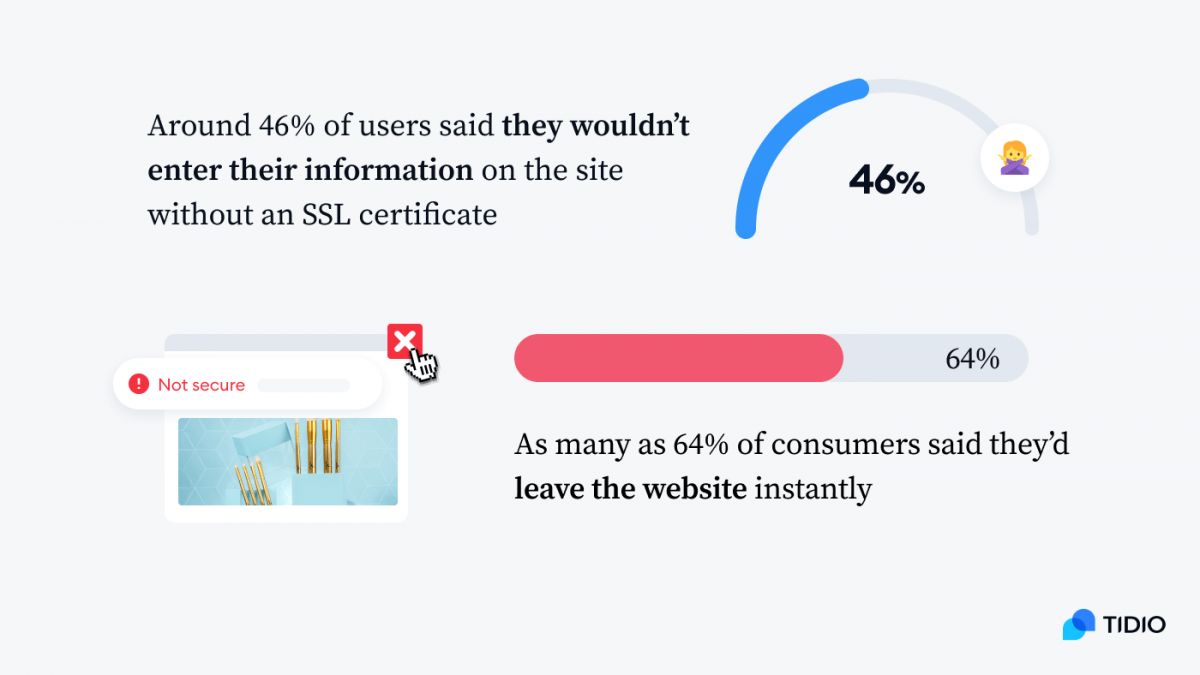
The winner in this category is: Shopify
Why?
Shopify offers an SSL certificate and is PCI-DSS compliant. This means that the security is taken care of, for you. Conversely, you need to source SSL and set up PCI-DSS yourself, if you go for WooCommerce.
| WooCommerce | Shopify 🏆 |
|---|---|
| – Self-hosted – SSL certificate must be sourced by a web hosting party (for example, Bluehost) – You need to make it PCI-DSS compliant manually | – Hosted platform – Built-in SSL certificate – PCI-DSS compliant |
The main difference
SSL (Secure Sockets Layer) safeguards personal information from being stolen from a website. PCI-DSS (Payment Card Industry Data Security Standard) enables your ecommerce company to legally process credit card payments. Because WooCommerce is a part of WordPress, an open-sourced platform, you are responsible for providing these security commodities for your customers. At the same time, Shopify is a hosted platform, which means that all security measures are taken care of for you.
Where does Shopify beat WooCommerce?
Shopify comes with all security features built-in, as opposed to its competitor.
Worth mentioning
Bluehost provides a free SSL certificate in its WooCommerce plans. To make WooCommerce PCI-DSS compliant, however, you need to follow specific steps.
An opinion from a content Shopify user on Quora:
Shopify wins because they are managed hosting, they manage the security, back-ups and other things you might not even know needs to be managed as a beginner.
Suggested read
See how to safely install Tidio on Shopify.
Shopify vs WooCommerce: transaction fees and payment options
It’s obvious that if you sell online, you need to enable your customers to pay for their purchases. Wordplay Global reports that 44.5% of total ecommerce payments are made using digital and mobile wallets, while credit and debit cards are a close second (22.8%). To accommodate all your customers, it’s best to provide a variety of payment gateways. However, these can come with transaction fees. Let’s see which platform makes the payments simple and smooth.
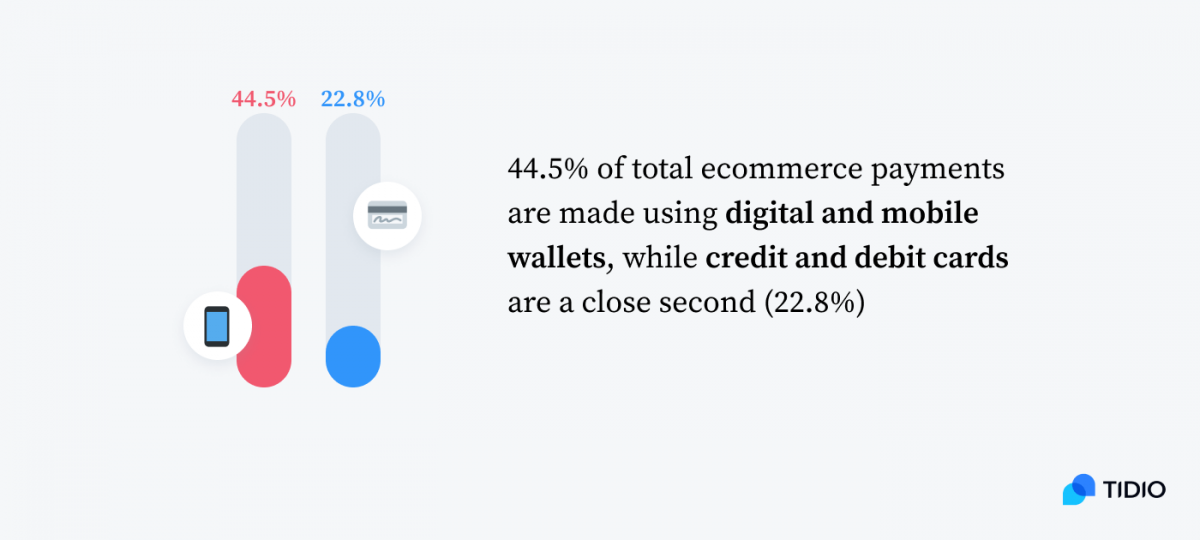
The winner in this category is: WooCommerce
Why?
WooCommerce doesn’t charge additional transaction fees, as opposed to Shopify.
| WooCommerce 🏆 | Shopify |
|---|---|
| – A number of default payment checkouts (BACS, Check Payments, Cash on Delivery, PayPal Standard) – 100+ supported payment add-ons – No additional transaction fees with third-party payment getaways – Bank charges apply based on the payment provider | – 100+ supported payment add-ons – 2% per transaction with a third-party gateway – Native payment option, Shopify payments, necessary to avoid paying a 2% surplus – Credit card and bank charges apply |
The main difference
Both WooCommerce and Shopify support over 100 payment add-ons, including:
- PayPal
- Stripe
- Apple Pay
- Square POS
- Credit cards
- Debit cards
You will always pay the bank or payment provider charges. But Shopify additionally charges a 2% fee for every transaction. You can avoid it only if you use their native solution, Shopify payments, and it’s not available in every country.
Where does WooCommerce beat Shopify?
WooCommerce gives you more freedom to choose a variety of payment add-ons based on your needs, and it doesn’t charge its own transaction fees.
Worth mentioning
Just like Shopify, WooCommerce provides a native payment solution, WooCommerce Payments. Its main purpose is to manage all transactions from one dashboard.
One Quora user said…
WooCommerce will be cheaper when it comes to processing, and you will have more options. With Shopify, you are paying them [first], then [you pay] the processor. WooCommerce doesn't take a dime and lets you choose any processor.
WooCommerce and Shopify: sales features
The very existence of ecommerce stores depends on whether they sell their products. Of course, sales are affected by the quality of products or even the website’s aesthetics… but good sales features can help you sell more effectively. Which platform offers better tools for boosting your revenue?
The winner in this category is: Shopify
Why?
Shopify offers a variety of sales features built directly into the system, whereas WooCommerce native sales tools are very limited.
| WooCommerce | Shopify 🏆 |
|---|---|
| – Few standard sales features built-in: one-click refund, embedding suggested products on different product pages, possibility to customize the checkout – A variety of paid sales add-ons available | – Built-in sales features: abandoned cart recovery, bulk discounts’ creator, gift cards creator – Partnerships with shipping companies |
The main difference
WooCommerce is built with customizing in mind, so every store owner can mix and match their preferred add-ons. Conversely, Shopify offers many useful tools as an intrinsic part of its platform.
For example:
- Shipping: Both platforms enable you to offer free shipping, but Shopify also partners with USPS, DHL Express, UPS, and Canada Post, so you don’t have to source your own courier
- Shopping cart recovery: Shopify allows customers to complete the abandoned cart order without the need to fill out their details.
Where does Shopify beat WooCommerce?
Shopify comes with many more ecommerce sales features built-in, as opposed to WooCommerce.
Worth mentioning
If you consider blogging a highly successful sales and marketing tactic, it’s worth noticing that both Shopify and WooCommerce come with free blogging platforms.
One Quora opinion reads like this:
WooCommerce is a plugin that enables ecommerce-like functions to an existing WordPress site. (…) Shopify is a platform built specifically for ecommerce. Every website comes with a shopping cart, checkout pages, payment gateways, etc.
Comparing Shopify to WooCommerce: marketing features
Boosting sales is one thing. But what about attracting new customers and showcasing your products to a bigger audience? This is where marketing comes in. Let’s see which solution provides better marketing tools.
The winner in this category is: Shopify
Why?
Shopify provides an impressive variety of marketing features as a part of every plan.
| WooCommerce | Shopify 🏆 |
|---|---|
| – Paid multichannel selling (only Facebook integration is free of charge) – Paid email marketing integrations | – Multichannel selling on all platforms, free of charge – Free email marketing |
The main difference
Just as with sales features, WooCommerce relies on paid plugins when it comes to marketing tools, as opposed to Shopify.
For example:
- Multichannel selling: With both platforms, you can sell your products on Amazon and eBay; as well as social media platforms such as Instagram, Pinterest, and Facebook. However, Shopify won’t charge you for integrating your shop with them, while WooCommerce will require you to pay for each of them, which adds to around $80 (excluding Facebook, which is free).
- Email marketing campaigns: Shopify has launched its own email marketing tool. It’s also easy to integrate with Seguno, Constant Contact, or Sendinblu. WooCommerce, on the other hand, offers integration with Mailchimp, a popular email marketing tool.
Where does Shopify beat WooCommerce?
Shopify provides more marketing tools as part of their system, for free. WooCommerce provides Facebook and Mailchimp integrations for free, but you need to pay for access to the rest of the top-quality platforms.
Worth mentioning
Shopify’s email marketing tool allows you to send up to 2.5k emails for free and then charges you $1 for every 1,000 emails sent.
One Quora user said this:
[Shopify] will take care of your hosting space, script, and data, manage traffic, and autointegration of sales channels.
Suggested read
See how to install the Tidio plugin on WordPress.
Comparing Shopify to WooCommerce: SEO capabilities
We cannot talk about marketing without SEO (Search Engine Optimization). A well-optimized ecommerce website guarantees visibility in Google’s search results and bigger exposure to potential buyers. Your ecommerce platform of choice should make it as easy as possible!
The winner in this category is: WooCommerce
Why?
WooCommerce provides a wide range of robust SEO plugins, such as famous Yoast SEO. In comparison to WooCommerce, Shopify’s offer is quite limited.
| WooCommerce 🏆 | Shopify |
|---|---|
| – Built with SEO-optimized code – Integrated with a native WordPress plugin, Yoast SEO – A wide range of SEO plugins – Offers SEO guides and prompts | – Limited SEO plugins – Free SEO booster plugin |
The main difference
With WooCommerce, you can easily add detailed meta titles and descriptions, as well as customize your URLs to tell Google what your website is about. On top of that, WooCommerce is integrated with WordPress, which means that you can choose from a vast range of effective and popular SEO tools. Shopify doesn’t have as many additional plugins to offer, which may be limiting.
Where does WooCommerce beat Shopify?
With WooCommerce, you don’t have to worry about using an “ecommerce plugin” for your SEO, because all SEO tools for WordPress websites work for WooCommerce as well. You can test them and choose the one that works best for you.
Worth mentioning
SEO Booster, a native Shopify plugin for SEO, can scan your website in search of potential issues that may be harming your performance.
One Quora opinion stated:
WooCommerce uses all the WordPress plugins, and there are a plethora of developers that improve the script every day; It’s very easy to rank [on Google].
Shopify vs WooCommerce: support
Both platforms are relatively easy to use, but everybody needs some help from time to time! Especially ecommerce owners who may need assistance with inventory management, expansion, or payments. Let’s see which platform provides the best customer support.
The winner in this category is: Shopify
Why?
Shopify offers excellent customer support 24/7 via phone, live chat, and email, while WooCommerce doesn’t have official customer support.
| WooCommerce | Shopify 🏆 |
|---|---|
| – Ticket support – Vast knowledge center and library of tutorials – Dedicated forums | – 24/7 phone, live chat, and email support – Vast knowledge base & FAQs – Community forums |
The main difference
Shopify provides excellent service to its users via telephone, live chat, and email. If you face an urgent problem, you just need to contact the Shopify support team and usually, they will get back to you relatively quickly. WooCommerce’s support, on the other hand, officially doesn’t exist. Even though Woo offers a vast library of guides and docs, the lack of 24/7 human support may be troublesome.
Where does Shopify beat WooCommerce?
Tech-savvy WooCommerce users claim that you can solve almost any issue by looking into their doc-base. In contrast, Shopify users praise the accessibility of human support of their platform of choice.
Worth mentioning
You can contact customer support regarding WooCommerce if you use the services of their dedicated hosting provider, Bluehost.
One happy Shopify user said this on Quora:
In terms of customer service, Shopify's performance is more desirable. It provides 24/7 customer support for all users, and sellers can contact customer service staff at any time via email, online chat, or phone.
WooCommerce vs Shopify: dropshipping
Dropshipping is an online business where you don’t need to have any products in stock. Instead, when a customer orders the product on your website, you simply transfer the orders to the supplier, who then sends them directly to the customer. Which platform is better for dropshipping? Let’s see.
The winner in this category is: It’s a tie!
Why?
Both WooCommerce and Shopify have integrations that allow you to personalize white-label items, import products, and fulfill orders. At the same time, each of these integrations has its own pricing plans, membership subscriptions, and other additional charges.
| WooCommerce 🏆 | Shopify 🏆 |
|---|---|
| Integrates with the majority of dropshipping apps on the market: – WooCommerce Dropshipping – AliDropShip – DropshipMe – WP Amazon Shop | Integrates with the majority of dropshipping apps on the market: – Oberlo – Modalyst – Spreadr – Spocket |
The main difference
Each WooCommerce shop technically works on a WordPress site, an open-source platform. This means that you have full control over the products that you sell—they just need to be legally obtainable in a customer’s location. In contrast, every Shopify member must follow the Acceptable Use Policy, because Shopify is officially an ecommerce platform. This means that you cannot sell restricted items, like firearms. For people who want to sell more everyday items, like clothes, pet products, or jewelry, it shouldn’t be a problem, though.
Worth mentioning
With WooCommerce, you can also create a multivendor website marketplace, similar to eBay or Amazon.
One Quora user said this on the subject:
I would look into which platform your dropshipper’s integrated with the best. Test out both platforms and see which provides the least friction with creating products, sending purchases to the dropshipper, and fulfilling the order.
Suggested reads
Read all you need to know about Shopify dropshipping or find out how to start a dropshipping business.
WooCommerce vs Shopify: who should use what?
Now that you know all about the two giants of ecommerce, you might feel overwhelmed when it comes to making a decision. To make it a bit easier, we prepared a little cheat sheet. Have a look and see how many positions you can tick on each side!
| Use WooCommerce if you… | Use Shopify if you… |
|---|---|
| – Already have a WordPress website and want to build your store on it to avoid additional expenses. – Require full control of each and every aspect of your online store. – Prefer to do everything on your own, and know-how to get your site up and running. – Can survive having no customer support 24/7. | – Have no website but want to have an online store up and running quickly with minimal effort. – Are not keen on the ecommerce platform’s tech side, and you simply want it to look great and to work well. – Opt for a full-package, in which all you need to do is sign up and follow a few simple instructions. – Have no problems paying for all features, even if not all of them would be used by you. |
Read more: Discover the best Shopify alternatives for your ecommerce business.
WooCommerce vs Shopify FAQ
If you have a technical skillset and appreciate flexibility, then WooCommerce may be a better option for you. If you want to have a full package, and not worry about technical aspects, then Shopify is a better option for your business.
Yes, you can easily migrate between WooCommerce and Shopify and the other way round. It’s better to choose wisely from the beginning and avoid an unnecessary migration process, but both Shopify and WooCommerce provide handy manuals on how to do it.
WooCommerce is a fully open-source platform, while Shopify offers a 14-day trial period. However, WooCommerce requires web hosting, and Shopify charges a subscription fee each month. This means that each platform comes with costs.
WooCommerce vs. Shopify: Summary
Now you should have an idea of what is better for your ecommerce business. Let’s recap the most important info:
- Shopify is an ecommerce platform with all the relevant features built in. WooCommerce, on the other hand, is a plugin that can transform a WordPress website into an ecommerce store.
- Shopify is a full-package product, while WooCommerce is built with constant development and expansion in mind. That’s why Shopify is better for beginners, and WooCommerce is better for store owners with basic technical skills.
- While Shopify is overall easier to use and manage, it has its limitations. WooCommerce is more flexible.
- What you choose should depend on your skills, approach, specific technical requirements, and pricing expectations.
We believe that you will make the most of your choice! And if you need help with adding live chat and chatbots to your Shopify or WooCommerce, don’t hesitate to write to us. We integrate with both!
